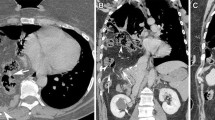Abstract
The objectives of our study were to describe a new CT sign of diaphragmatic injury, the “dangling diaphragm” sign, and assess its comparative utility relative to other signs in the diagnosis of diaphragmatic injury resulting from blunt trauma. CT scans of 16 blunt trauma patients (12 men and four women, mean age 36.6 years old) with surgically proven diaphragmatic injury and 32 blunt trauma patients (24 men and eight women; mean age 37.4 years old) without evidence of diaphragmatic injury at surgery were blindly reviewed by three board certified radiologists specializing in body imaging. Studies were evaluated for the presence of established signs of diaphragmatic injury, as well as the dangling diaphragm sign, in which the free edge of the torn hemidiaphragm curls inward from its normal course parallel to the body wall. The sensitivity and specificity of each sign were determined, as were the correlation between the signs and the interobserver agreement in evaluation of these findings. The radiologists’ overall impression as to whether rupture was present was also recorded. In select cases, coronal and/or sagittal reformatted images were available, and they were reviewed following evaluation of the original axial images. Any change in interpretation due to these images was noted. The sensitivity of the radiologists’ overall impression for detection of diaphragmatic injury was 77%, with 98% specificity. Individual signs of diaphragmatic injury had sensitivities ranging from 44% to 69%, with specificities of 98% to 100%. The dangling diaphragm sign had a sensitivity of 54% and a specificity of 98%, similar to the other signs. Multiple signs were present in most cases of diaphragmatic injury, and coronal and sagittal reformatted images had little impact. Diaphragmatic injury remains a challenging radiographic diagnosis. The dangling diaphragm is a conspicuous sign of diaphragmatic injury, and awareness of it may increase detection of diaphragmatic injury on CT studies.






Similar content being viewed by others
References
Meyers BF, McCabe CJ (1993) Traumatic diaphragmatic hernia. Occult marker of serious injury. Ann Surg 218:783–790. doi:10.1097/00000658-199312000-00013
Sangster G, Ventura VP, Carbo A, Gates T, Garayburu J, D’Agostino H (2007) Diaphragmatic rupture: a frequently missed injury in blunt thoracoabdominal trauma patients. Emerg Radiol 13:225–230. doi:10.1007/s10140-006-0548-y
van de Ven K, Vanclooster P, de Gheldere C, Meersman A, Verhelst F (1995) Strangulation: a late presentation of right-sided diaphragmatic rupture. Acta Chir Belg 95:226–228
Wright BE, Reinke T, Aye RW (2005) Chronic traumatic diaphragmatic hernia with pericardial rupture and associated gastroesophageal reflux. Hernia 9:392–396. doi:10.1007/s10029-005-0339-5
Barbiera F, Nicastro N, Finazzo M et al (2003) The role of MRI in traumatic rupture of the diaphragm. Our experience in three cases and review of the literature. Radiol Med (Torino) 105:188–194
Blaivas M, Brannam L, Hawkins M, Lyon M, Sriram K (2004) Bedside emergency ultrasonographic diagnosis of diaphragmatic rupture in blunt abdominal trauma. Am J Emerg Med 22:601–604. doi:10.1016/j.ajem.2004.08.015
Kim EE, McConnell BJ, McConnell RW, Duke JH, Dillon M (1983) Radionuclide diagnosis of diaphragmatic rupture with hepatic herniation. Surgery 94:36–40
Nchimi A, Szapiro D, Ghaye B et al (2005) Helical CT of blunt diaphragmatic rupture. AJR 184:24–30
Gelman R, Mirvis SE, Gens D (1991) Diaphragmatic rupture due to blunt trauma: sensitivity of plain chest radiographs. AJR 156:51–57
Shapiro MJ, Heiberg E, Durham RM, Luchtefeld W, Mazuski JE (1996) The unreliability of CT scans and initial chest radiographs in evaluating blunt trauma induced diaphragmatic rupture. Clin Radiol 51:27–30. doi:10.1016/S0009-9260(96) 80214-5
Murray JG, Caoili E, Gruden JF, Evans SJ, Halvorsen RA Jr, Mackersie RC (1996) Acute rupture of the diaphragm due to blunt trauma: diagnostic sensitivity and specificity of CT. AJR 166:1035–1039
Israel RS, McDaniel PA, Primack SL, Salmon CJ, Fountain RL, Koslin DB (1996) Diagnosis of diaphragmatic trauma with helical CT in a swine model. AJR 167:637–641
Larici AR, Gotway MB, Litt HI et al (2002) Helical CT with sagittal and coronal reconstructions: accuracy for detection of diaphragmatic injury. AJR 179:451–457
Kaya SO, Karabulut N, Yuncu G, Sevinc S, Kiroglu Y (2006) Sinus cut-off sign: a helpful sign in the CT diagnosis of diaphragmatic rupture associated with pleural effusion. Eur J Radiol 59:253–256. doi:10.1016/j.ejrad.2006.04.015
Bergin D, Ennis R, Keogh C, Fenlon HM, Murray JG (2001) The “dependent viscera” sign in CT diagnosis of blunt traumatic diaphragmatic rupture. AJR 177:1137–1140
Killeen KL, Mirvis SE, Shanmuganathan K (1999) Helical CT of diaphragmatic rupture caused by blunt trauma. AJR 173:1611–1616
Rees O, Mirvis SE, Shanmuganathan K (2005) Multidetector-row CT of right hemidiaphragmatic rupture caused by blunt trauma: a review of 12 cases. Clin Radiol 60:1280–1289. doi:10.1016/j.crad.2005.06.013
Author information
Authors and Affiliations
Corresponding author
Rights and permissions
About this article
Cite this article
Desser, T.S., Edwards, B., Hunt, S. et al. The dangling diaphragm sign: sensitivity and comparison with existing CT signs of blunt traumatic diaphragmatic rupture. Emerg Radiol 17, 37–44 (2010). https://doi.org/10.1007/s10140-009-0819-5
Received:
Accepted:
Published:
Issue Date:
DOI: https://doi.org/10.1007/s10140-009-0819-5




